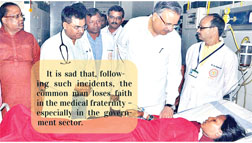 Intro: Sterilisation surgeries that went horribly wrong in Bilaspur, Chhattisgarh, have raised many questions and issues. How sincere is the commitment of the medical fraternity towards public health? In modern India, is a woman still seen as just a child-bearing machine, with no mind of her own? Why is female sterilisation still the cornerstone of India’s family planning programme?? ?
Intro: Sterilisation surgeries that went horribly wrong in Bilaspur, Chhattisgarh, have raised many questions and issues. How sincere is the commitment of the medical fraternity towards public health? In modern India, is a woman still seen as just a child-bearing machine, with no mind of her own? Why is female sterilisation still the cornerstone of India’s family planning programme?? ?
Almost like assembly-line production, 83 women were operated upon for sterilisation purpose in just about five hours. That works out to less than three minutes per woman! All women fell ill immediately after. Twelve died, and about 50 are still in various hospitals.
The venue for the sterilisation camp was a ‘dingy abandoned hospital with cracking floors and rusted, inadequate beds and tables’. Reports suggest the surgical instruments were ‘rusty’ and unhygienic to begin with, and were repeatedly used without any attempt at sterilisation during the marathon surgeries.
 The surgeries were conducted on November 8 at a free government-run ‘family planning camp’ in Pendri Village at Bilaspur. Two more such camps were organised in the next two days within a few kilometers of the first. One more woman died at one of these camps, taking the total death toll to 13. Almost all the 130-odd women who underwent laparoscopic tubectomies at the camps between November 8 and 10 are said to have fallen ill.
The surgeries were conducted on November 8 at a free government-run ‘family planning camp’ in Pendri Village at Bilaspur. Two more such camps were organised in the next two days within a few kilometers of the first. One more woman died at one of these camps, taking the total death toll to 13. Almost all the 130-odd women who underwent laparoscopic tubectomies at the camps between November 8 and 10 are said to have fallen ill.
Women reportedly showed signs of toxic shock, possibly because of dirty surgical equipments or contaminated medicines. Surgeon Dr RK Gupta was arrested for the botch-up, but he denied any wrongdoing on his part. Instead, he put the blame on the administration and the medicines.
The issue of target-based mass sterilisation camps came up. There was a raging debate on whether or not medical officers are under pressure to manage a targeted number of sterilisation surgeries within a stipulated time-period. Some officers confirmed there was, others denied.
“It is up to the administration to decide how many women would be kept for operation. If they kept in that place 83 women, it is my moral responsibility to operate (on) all the women. If I decline to do that I would have faced public agitation,” Gupta told a news agency. Gupta further said the possible cause of death could have been faulty medication that was handed out by health workers.
The focus shifted to medical supplies also. Were they sub-standard or spurious? Then, reports said rat poison was detected in the antibiotic drug administered to the women post-surgery. A manufacturing company, Mahawar Pharma, was identified as the ‘culprit’. Company owner Ramesh Mahawar and son Sumit were arrested and charged with cheating. They have denied there was anything wrong with their medicines. The Food and Drug Administration (FDA) has sealed the company’s manufacturing unit in Bilaspur district. A significant quantity of drugs was reportedly found burnt at the premises.
The big question was how could contaminated medicine find its way to a government-sponsored camp? There are systems in place for quality check and supply of medicines. Reports suggest the set procedures whereby batches of medicines are checked and agreed had been bypassed.
Heads have started rolling. The State government suspended Dr RK Gupta, Block Medical Officer of Takhatpur Dr Pramod Tiwari, Bilaspur CMO RK Bhange and State Coordinator of Family Planning Programme KC Uraon, and ordered an FIR against them. Director, Health Services, Dr Kamalpreet Singh was also transferred.
Ironically, the 59-year-old surgeon who conducted these operations received an award earlier this year, on Republic Day, from the State Health Minister Amar Agarwal for conducting 50,000 laparoscopic tubectomies in his career. With a year to go before he retires, the doctor faces charges for fatal negligence.
Tubectomy is considered a safe procedure if doctors follow guidelines. Death is extremely rare. Nevertheless, it is a major surgery and daily limits are prescribed. According to the Central government’s guidelines, a medical team cannot conduct more than 30 laparoscopic tubectomies in a day, with three separate laparoscopes — that means not more than 10 tubectomies with a single instrument, as each instrument needs to be properly sterilised after every operation. The guidelines state that if there are additional surgeons, instruments and supplies, the number of operations per team can be increased, but in no case should it exceed 50. Even then, it puts a cap of 10 operations by a single surgeon with a single instrument.
In this case, more than double the stipulated number of surgeries was conducted in a matter of hours. Local health workers indicate that sometimes the number at such camps exceeds 100!
Reportedly encouraged by cash incentives, about 4 million people undergo surgery every year. Almost all are women. Nearly 600 deaths were reported between 2009 and 2012, according to data.
The guidelines further specify that all sterilisation camps must be organised only at “established healthcare facilities” recognised by the Government of India. Here, the camp site was a private charitable hospital which is closed, almost abandoned, since April this year. It seems the Trust that owns the hospital was not even aware their premises were being used for the camp.
The post-operative antibiotic drug, Ciprocin 500 tablets, distributed at the three sterilisation camps under the spotlight was reportedly found contaminated with zinc phosphide. State Principal Secretary (Health) Dr Alok Shukla said the symptoms shown by all the patients — stomach pain and vomiting, followed by multiple organ failure in those who died — matched those associated with zinc phosphide poisoning. Zinc phosphide is used in rat poison.
The contamination theory gains credence, as experts point out that a substandard version of ciprofloxacin could not have immediately turned toxic and killed patients. At the most, it would fail to prevent post-operative infection. A severe post-operative infection usually causes death after several days through a sequence of symptoms such as high fever, sepsis and multi-organ failure.
Another astonishing fact came to light – even women from endangered tribes were not spared. Sterilisation of Baiga—a primitive and endangered tribe in Chhattisgarh—is prohibited. But 30-year-old Chaiti Bai became the 13th woman to die. She was among the half-a-dozen women sterilised from Baigatola, a village nearly 100 km from Bilaspur. The simple Baiga women are not necessarily aware of the law and they get persuaded to sterilisation centres by health workers. They are made to sign a consent form that makes the operation legal and absolves the health officials of all responsibility.
The moot question is: What does ‘consent’ mean when it is from people who have little knowledge, awareness or access to other family planning options. These communities are so marginalised and, at times, uneducated that they don’t even understand surgical procedures and their rights.
Autopsy and other reports will make the picture clearer about what actually happened. This was either the most botched up mass surgery of the century or else the culprits have quite successfully managed to confuse the issues.
Whatever be the case, this one incident has thrown up a range of issues.
- Central Government guidelines and procedures were clearly violated.
- Basic medical ethics of surgery were ignored i.e. sterile surroundings, sterilised equipment, emergency facilities etc.
- Mandatory procedures for medical supplies not followed. Connivance of government officials and private players suspected.
However, one fact that has emerged crystal clear from this tragedy is the complete impunity with which ethics and procedures have been disregarded by government functionaries. Needless to say, this is not a one-off case. This callousness and indifference towards people’s health is witnessed in varying degrees across the country. The very doctors and medical officers who are given the responsibility of people’s health play havoc with it. It is sad that, following such incidents, the common man loses faith in the medical fraternity – especially in the government sector.
The terrible tragedy that has befallen on thirteen families should serve as an eye-opener. Lessons need to be learnt, so that mistakes are not repeated. Justice in this case should be quick and effective. Thirteen young women in their prime have lost their lives, simply because of someone’s criminal negligence or complicity. The culprits should not be spared at any cost. And, all State governments should ensure compliance of standard procedures and ethics at all levels in the health sector.
The government must also revisit its policies regarding family planning. Why is it always the woman who has to face the scalpel? Besides, there are so many other options available for contraception.
How often do health workers discuss vasectomies as a suitable alternative to female sterilisation and how often are couples counselled on other options? Moreover, statistics indicate that such sterilisation camps have had little or no effect on population control in actual terms. Some hard-thinking and quick decisions are called for. There should never be a repeat of the Bilaspur tragedy.
Abha Khanna Gupta ?(The writer is a senior journalist and social worker)
?













Comments